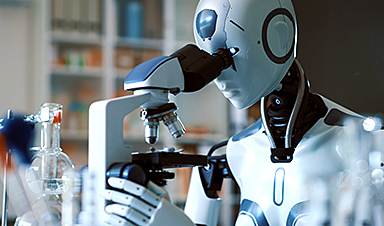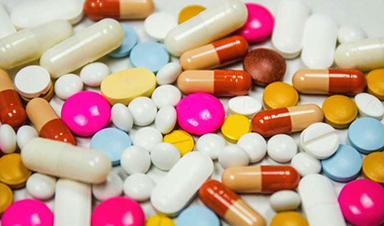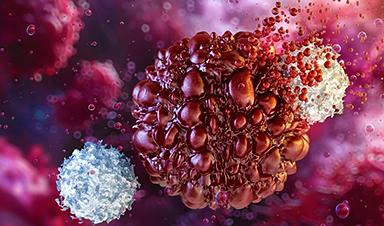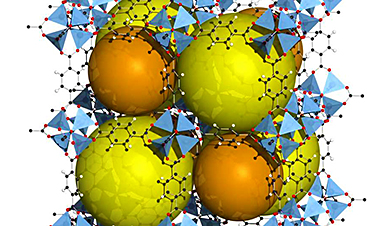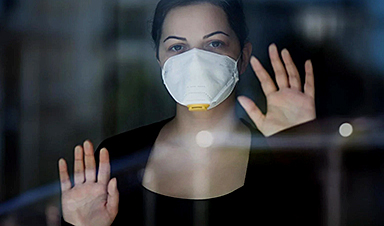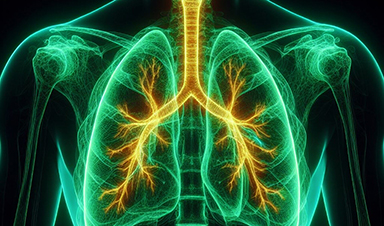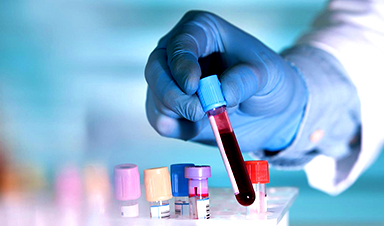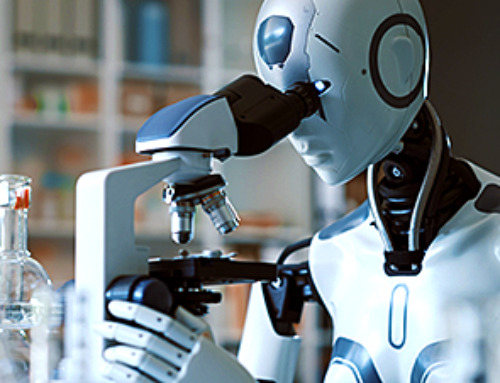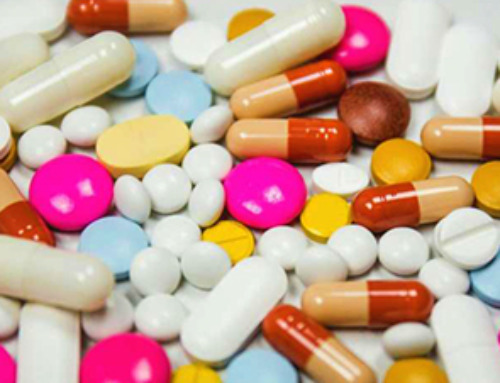We’ve all been more aware of lung health since Covid-19.
However, for people with asthma and chronic obstructive pulmonary disease (COPD), dealing with lung problems is a lifelong struggle. Those with COPD suffer from highly inflamed lung tissue that swells and obstructs airways, making it hard to breathe. The disease is common, with more than three million annual cases in the US alone.
Although manageable, there is no cure. One problem is that lungs with COPD pump out tons of viscous mucus, which forms a barrier preventing treatments from reaching lung cells. The slimy substance—when not coughed out—also attracts bacteria, further aggravating the condition.
A new study in Science Advances describes a potential solution. Scientists have developed a nanocarrier to shuttle antibiotics into the lungs. Like a biological spaceship, the carrier has “doors” that open and release antibiotics inside the mucus layer to fight infections.
The “doors” themselves are also deadly. Made from a small protein, they rip apart bacterial membranes and clean up their DNA to rid lung cells of chronic infection.
The team engineered an inhalable version of an antibiotic using the nanocarrier. In a mouse model of COPD, the treatment revived their lung cells in just three days. Their blood oxygen levels returned to normal, and previous signs of lung damage slowly healed.
“This immunoantibacterial strategy may shift the current paradigm of COPD management,” the team wrote in the article.
Breathe Me
Lungs are extremely delicate. Picture thin but flexible layers of cells separated into lobes to help coordinate oxygen flow into the body. Once air flows through the windpipe, it rapidly disperses among a complex network of branches, filling thousands of air sacs that supply the body with oxygen while ridding it of carbon dioxide.
These structures are easily damaged, and smoking is a common trigger. Cigarette smoke causes surrounding cells to pump out a slimy substance that obstructs the airway and coats air sacs, making it difficult for them to function normally.
In time, the mucus builds a sort of “glue” that attracts bacteria and condenses into a biofilm. The barrier further blocks oxygen exchange and changes the lung’s environment into one favorable for bacteria growth.
One way to stop the downward spiral is to obliterate the bacteria. Broad-spectrum antibiotics are the most widely used treatment. But because of the slimy protective layer, they can’t easily reach bacteria deep inside lung tissues. Even worse, long-term treatment increases the chance of antibiotic resistance, making it even more difficult to wipe out stubborn bacteria.
But the protective layer has a weakness: It’s just a little bit too sour. Literally.
Open-Door Policy
Like a lemon, the slimy layer is slightly more acidic compared to healthy lung tissue. This quirk gave the team an idea for an ideal antibiotic carrier that would only release its payload in an acidic environment.
The team made hollow nanoparticles out of silica—a flexible biomaterial—filled them with a common antibiotic, and added “doors” to release the drugs.
These openings are controlled by additional short protein sequences that work like “locks.” In normal airway and lung environments, they fold up at the door, essentially sequestering the antibiotics inside the bubble.
Released in lungs with COPD, the local acidity changes the structure of the lock protein, so the doors open and release antibiotics directly into the mucus and biofilm—essentially breaking through the bacterial defenses and targeting them on their home turf.
One test with the concoction penetrated a lab-grown biofilm in a petri dish. It was far more effective compared to a previous type of nanoparticle, largely because the carrier’s doors opened once inside the biofilm—in other nanoparticles, the antibiotics remained trapped.
The carriers could also dig deeper into infected areas. Cells have electrical charges. The carrier and mucus both have negative charges, which—like similarly charged ends of two magnets—push the carriers deeper into and through the mucus and biofilm layers.
Along the way, the acidity of the mucus slowly changes the carrier’s charge to positive, so that once past the biofilm, the “lock” mechanism opens and releases medication.
The team also tested the nanoparticle’s ability to obliterate bacteria. In a dish, they wiped out multiple common types of infectious bacteria and destroyed their biofilms. The treatment appeared relatively safe. Tests in human fetal lung cells in a dish found minimal signs of toxicity.
Surprisingly, the carrier itself could also destroy bacteria. Inside an acidic environment, its positive charge broke down bacterial membranes. Like popped balloons, the bugs released genetic material into their surroundings, which the carrier swept up.
Damping the Fire
Bacterial infections in the lungs attract overactive immune cells, which leads to swelling. Blood vessels surrounding air sacs also become permeable, making it easier for dangerous molecules to get through. These changes cause inflammation, making it hard to breathe.
In a mouse model of COPD, the inhalable nanoparticle treatment quieted the overactive immune system. Multiple types of immune cells returned to a healthy level of activation—allowing the mice to switch from a highly inflammatory profile to one that combats infections and inflammation.
Mice treated with the inhalable nanoparticle had about 98 percent less bacteria in their lungs, compared to those given the same antibiotic without the carrier.
Wiping out bacteria gave the mice a sigh of relief. They breathed easier. Their blood oxygen levels went up, and blood acidity—a sign of dangerously low oxygen—returned to normal.
Under the microscope, treated lungs restored normal structures, with sturdier air sacks that slowly recovered from COPD damage. The treated mice also had less swelling in their lungs from fluid buildup that’s commonly seen in lung injuries.
The results, while promising, are only for a smoking-related COPD model in mice. There’s still much we don’t know about the treatment’s long-term consequences.
Although for now there were no signs of side effects, it’s possible the nanoparticles could accumulate inside the lungs over time eventually causing damage. And though the carrier itself damages bacterial membranes, the therapy mostly relies on the encapsulated antibiotic. With antibiotic resistance on the rise, some drugs are already losing effect for COPD.
Then there’s the chance of mechanical damage over time. Repeatedly inhaling silicon-based nanoparticles could cause lung scarring in the long term. So, while nanoparticles could shift strategies for COPD management, it’s clear we need follow-up studies, the team wrote.
Image Credit:
News
How nanomedicine and AI are teaming up to tackle neurodegenerative diseases
When I first realized the scale of the challenge posed by neurodegenerative diseases, such as Alzheimer's, Parkinson's disease and amyotrophic lateral sclerosis (ALS), I felt simultaneously humbled and motivated. These disorders are not caused [...]
Self-Organizing Light Could Transform Computing and Communications
USC engineers have demonstrated a new kind of optical device that lets light organize its own route using the principles of thermodynamics. Instead of relying on switches or digital control, the light finds its own [...]
Groundbreaking New Way of Measuring Blood Pressure Could Save Thousands of Lives
A new method that improves the accuracy of interpreting blood pressure measurements taken at the ankle could be vital for individuals who are unable to have their blood pressure measured on the arm. A newly developed [...]
Scientist tackles key roadblock for AI in drug discovery
The drug development pipeline is a costly and lengthy process. Identifying high-quality "hit" compounds—those with high potency, selectivity, and favorable metabolic properties—at the earliest stages is important for reducing cost and accelerating the path [...]
Nanoplastics with environmental coatings can sneak past the skin’s defenses
Plastic is ubiquitous in the modern world, and it's notorious for taking a long time to completely break down in the environment - if it ever does. But even without breaking down completely, plastic [...]
Chernobyl scientists discover black fungus feeding on deadly radiation
It looks pretty sinister, but it might actually be incredibly helpful When reactor number four in Chernobyl exploded, it triggered the worst nuclear disaster in history, one which the surrounding area still has not [...]
Long COVID Is Taking A Silent Toll On Mental Health, Here’s What Experts Say
Months after recovering from COVID-19, many people continue to feel unwell. They speak of exhaustion that doesn’t fade, difficulty breathing, or an unsettling mental haze. What’s becoming increasingly clear is that recovery from the [...]
Study Delivers Cancer Drugs Directly to the Tumor Nucleus
A new peptide-based nanotube treatment sneaks chemo into drug-resistant cancer cells, providing a unique workaround to one of oncology’s toughest hurdles. CiQUS researchers have developed a novel molecular strategy that allows a chemotherapy drug to [...]
Scientists Begin $14.2 Million Project To Decode the Body’s “Hidden Sixth Sense”
An NIH-supported initiative seeks to unravel how the nervous system tracks and regulates the body’s internal organs. How does your brain recognize when it’s time to take a breath, when your blood pressure has [...]
Scientists Discover a New Form of Ice That Shouldn’t Exist
Researchers at the European XFEL and DESY are investigating unusual forms of ice that can exist at room temperature when subjected to extreme pressure. Ice comes in many forms, even when made of nothing but water [...]
Nobel-winning, tiny ‘sponge crystals’ with an astonishing amount of inner space
The 2025 Nobel Prize in chemistry was awarded to Richard Robson, Susumu Kitagawa and Omar Yaghi on Oct. 8, 2025, for the development of metal-organic frameworks, or MOFs, which are tunable crystal structures with extremely [...]
Harnessing Green-Synthesized Nanoparticles for Water Purification
A new review reveals how plant- and microbe-derived nanoparticles can power next-gen water disinfection, delivering cleaner, safer water without the environmental cost of traditional treatments. A recent review published in Nanomaterials highlights the potential of green-synthesized nanomaterials (GSNMs) in [...]
Brainstem damage found to be behind long-lasting effects of severe Covid-19
Damage to the brainstem - the brain's 'control center' - is behind long-lasting physical and psychiatric effects of severe Covid-19 infection, a study suggests. Using ultra-high-resolution scanners that can see the living brain in [...]
CT scan changes over one year predict outcomes in fibrotic lung disease
Researchers at National Jewish Health have shown that subtle increases in lung scarring, detected by an artificial intelligence-based tool on CT scans taken one year apart, are associated with disease progression and survival in [...]
AI Spots Hidden Signs of Disease Before Symptoms Appear
Researchers suggest that examining the inner workings of cells more closely could help physicians detect diseases earlier and more accurately match patients with effective therapies. Researchers at McGill University have created an artificial intelligence tool capable of uncovering [...]
Breakthrough Blood Test Detects Head and Neck Cancer up to 10 Years Before Symptoms
Mass General Brigham’s HPV-DeepSeek test enables much earlier cancer detection through a blood sample, creating a new opportunity for screening HPV-related head and neck cancers. Human papillomavirus (HPV) is responsible for about 70% of [...]

